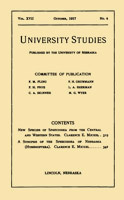University Studies of the University of Nebraska
Date of this Version
10-1908
Citation
UNIVERSITY STUDIES, Vol. VIII, No.4, October 1908.
Abstract
The following paper is the result of a study pursued by the writer at odd intervals during the past two years, and is based on the material contained in the collection of the University of Nebraska. Although the list is a fairly large one for a single state, nothing like systematic collecting has been done on the group, and it is expected that a great many additional species will be found in the near future. The only portion of the state that has been at all closely collected is Sioux county, where, during the past ten years, several zoological expeditions in charge of Professor Lawrence Bruner have been sent. This region is fast becoming famous from the standpoint of the zoologist as well, as the paleontologist, and from this locality many interesting records are obtained. Of the 200 species treated in this paper, 118 have been taken in Sioux county, and 60 of these have not been taken elsewhere within the state. With a single exception these trips were made during the month of August, so that in all likelihood, if the region were worked at some other time of the year, many other species would found. In oider to avoid repetition in the following pages it may be stated here that Indian creek, Jim creek, Monroe canyon, Warbonnet canyon, Agate, and Glen are found in the above mentioned county.
"Sphecoidea -- (archaic) A taxonomic superfamily within the order Hymenoptera – the sphecoid wasps, now treated as Spheciformes in Apoidea. The Spheciformes is a paraphyletic assemblage of insect families which collectively comprise the "sphecoid wasps". Larvae are carnivorous. These are all the members of the superfamily Apoidea, which are not bees and which in older classifications were called the "Sphecoidea". Some are also described as mud daubers."

